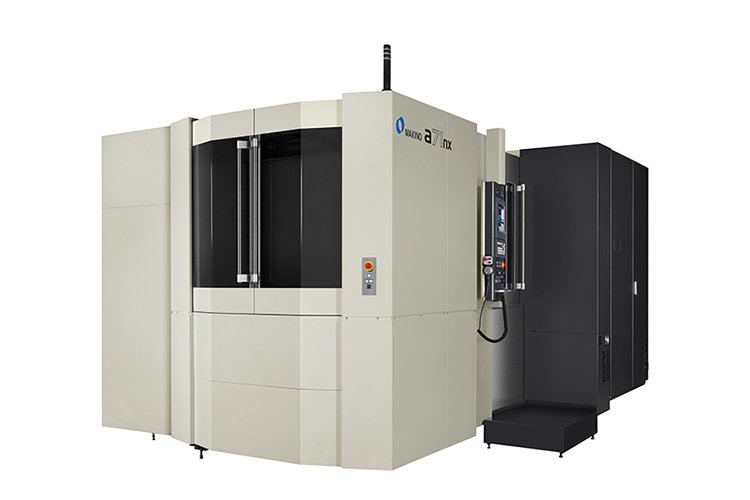Makino Introduces the New a71nx for Next-Generation Productivity and Reliability in Large Ferrous-Part Production
Makino is excited to announce the latest addition to its next-generation series of horizontal machining centers, the a71nx. This horizontal machine platform extends the capabilities of the original a71 with a host of brand-new features and technologies, including an expanded work envelope, improved ergonomics, increased spindle torque, innovative tool monitoring, advanced motion controls and the new Professional 6 control. The net result is a true next-generation machine platform designed with the most advanced capabilities for productivity, accuracy and reliability.
“The a71nx expands on all of the characteristics that made the original a71 an industry leader,” said David Ward, product marketing manager at Makino. “By expanding machine capacity and integrating cutting-edge technologies, like Vision B.T.S. [broken-tool sensing] and advanced motion controls, Makino has successfully leveraged proven design attributes while enhancing the productive capabilities and overall reliability.”
Designed for the production of midsized cast iron and light alloy parts, the a71nx features a 19.7-inch (500-mm) pallet and added extensions in the X, Y and Z axes, bringing full-axis travels to 31.5 inches, 29.5 inches and 32.7 inches (800 mm, 750 mm and 830 mm), respectively. The expanded axis travels increase the total machining volume 16 percent compared to the original a71. To accommodate these larger workpieces, the maximum payload was also raised, providing capacity for parts weighing up to 1,000 kg.
Larger parts frequently require larger tools. As such, the a71nx has been updated to handle longer and heavier tools. The machine’s standard 60-tool-capacity automatic tool changer (ATC) has six reinforced pockets, yielding a maximum tool length of 18.9 / 22.4 inches (Cat / HSK) and maximum weight of 30 kg.
Additionally, the original a71’s standard worm-gear-driven NC rotary table has been replaced with a direct-drive (DD) motor B-axis table for dramatically faster indexing time. The 1-second 90-degree rotation improves production processes with a substantial reduction in non-cutting motion. The DD motor table on the a71nx also reduces B-axis complexity and eliminates backlash and key component wear for improved reliability.
Enhanced Material Removal and Spindle Reliability
The a71nx takes spindle reliability and productivity to a new level with an updated high-power spindle design. With options available for CAT-50, BT 50 and HSK-A100 interfaces, the standard 10,000-rpm spindle offers 37kW of power (26kW continuous power) and 512 Nm of torque (305 Nm continuous), delivering the flexibility and speed necessary to efficiently machine a variety of ferrous, hard metal or light alloy workpieces. The large-diameter angular contact bearings and direct-inject air-oil lubrication ensure the highest level of rigidity and longevity. An optional 20,000-rpm core-cooled spindle is also available.
Built for Strength and Rigidity
Similar to other Makino nx-Series horizontal machining centers, the a71nx benefits from an innovative casting design and axis construction. The tiered, or stepped, column casting and oversized roller linear guides boost rigidity, eliminate vibration and extend perishable tool life even in the most challenging materials.
Chip and coolant management has been improved with the addition of a standard hydro-cyclonic filtration system. This system cleans coolant down to a 20 μm level, extending the maintenance life of the coolant.
Reducing Non-Cut Times
One of the key advantages of the a71nx is its ability to reduce non-cut time from part processes with innovative, patent-pending hardware and control features.
A vision-type broken-tool sensor (Vision B.T.S.) comes standard, supporting unattended operation by quickly validating the condition of cutting tools after each tool change. By creating a silhouette of the cutting tools, Vision B.T.S. is also able to evaluate the size and approximate weight of the tool. This information can then be applied to automatically set the tool-change speed to the appropriate setting (fast, medium or slow). The Vision B.T.S. system has fewer moving parts and requires no physical contact with the cutting tool, resulting in enhanced, long-term reliability and no risk of chipping delicate tool materials, such as polycrystalline diamond (PCD).
The a71nx is also equipped with the latest inertia active control (IAC) technologies, providing enhanced acceleration and deceleration rates in the B-axis, Z-axis and rotational positioning of the ring-type tool magazine. By quickly evaluating the total weight placed on these axes, IAC technology is able to instantly adjust acceleration to match the total load, reducing non-value-added times from part processes.
With the addition of the new Professional 6 (Pro6) control, the a71nx is equipped with two of the latest forms of advanced motion control to minimize non-cut time:
– GI Drilling is a unique G-code drilling cycle that enables the spindle and tool to arc from hole to hole instead of following a square path. This simple change reduces non-cut time by as much as 15 percent on common hole-pattern drilling.
– GI Milling is designed to improve performance in 2-D milling. GI Milling lets the user define a corner-rounding tolerance on each milling path. Even a small tolerance enables the machine to quickly flow through the cut path, completing milling paths in less time.
Together, these functions substantially cut costs in both high-volume and low-volume production environments by reducing the number of spindles required and freeing up machine availability to take on more work.
Enhanced Operability and Automation
The exterior of the a71nx has evolved in an effort to make maintaining the machine easier for the operator. An L-shaped door, when open, allows more light to enter the machine and prevents fluid from dripping onto the operator during inspection and maintenance. The wide opening on the pallet-loading station doors lends easy access for loading of fixtures and large workpieces. This type of accessibility is crucial for part loading and unloading in robot-automated environments.


